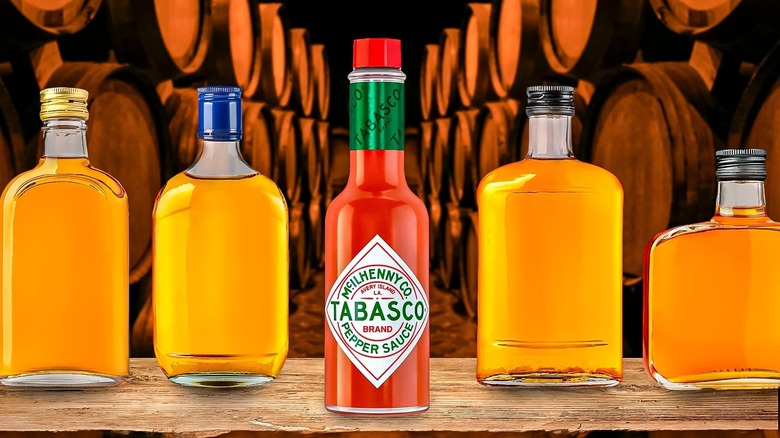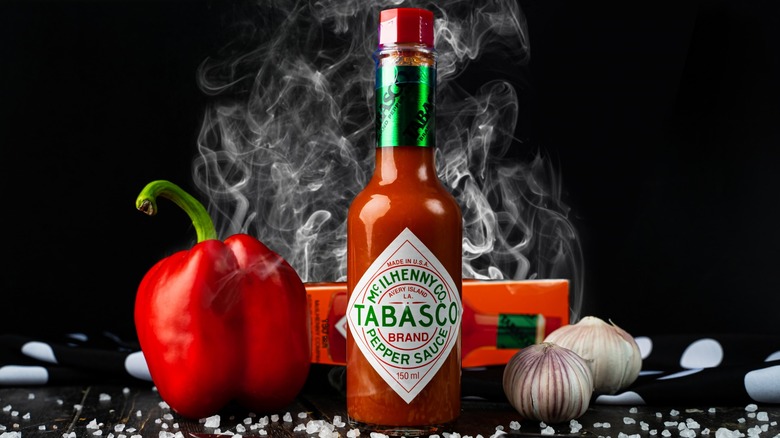Why Whiskey Barrels Are Key To Making Tabasco Sauce
A dash of Tabasco in a boozy bloody mary brings the brunch favorite to life, but the idea of combining Louisiana hot sauce with a shot of Jack Daniel's is decidedly less appealing. So, it may come as a bit of a surprise to bourbon and Tabasco lovers alike that the production of the spicy pepper blend Edmund McIlhenny created in 1868 is inextricably linked to bourbon. Here's the deal. For most of its 150-year-plus history, authentic Louisiana Tabasco has been aged exclusively in recycled white oak bourbon barrels. That wasn't the original plan, though.
Until about 1900, the McIlhenny Company — creator of Tabasco sauce — aged its pepper mash in stoneware jars. No one, not even McIlhenny Company blending manager Coy Boutte, is quite sure why the company made the switch to aging Tabasco in recycled white oak barrels, but the change stuck. Deemed the "unsung heroes of the aging process," according to a Q&A blog on the Tabasco website, the barrels come from bourbon distilleries across the United States, including Tennessee's Jack Daniel's, the nation's oldest registered bourbon distillery.
And as long as there's a demand for bourbon, the supply of used bourbon barrels will never run low. That's because the U.S. Alcohol and Tobacco Tax and Trade Bureau (TTB) mandates that bourbon must age in containers made from new oak. In other words, when it comes to bourbon barrels, the prevailing rule is one and done. Apparently, the stipulation ensures that the resulting spirit will pick up the essence of the charred white oak, giving it the slightly sweet flavor bourbon aficionados know and love.
The secrets of the sauce
Will you detect a hint of bourbon in your Tabasco? Probably not. According to Coy Boutte in a Q&A on the Tabasco website, McIlhenny Company employees fastidiously scrub the once-used barrels clean, removing all traces of the bourbon char, before fitting them with new stainless steel rings and deeming them ready to take their place on the production line. The turnover process removes any lingering traces of alcohol from the wood. What happens next? Boutte explained the time-tested process.
In the early days, all of the peppers (Capsicum frutescens, to be exact) used to make Tabasco, were grown within shouting distance of the Tabasco processing plant on Avery Island, a 2,200-acre salt dome about 30 miles south of Lafayette, Louisiana. As demand grew, the company began to import the raw produce from locations throughout the Americas and South Africa. Once the peppers ripen to a carefully monitored shade of red, they are harvested by hand and mixed with a bit of salt to create a mash.
The mash is then shipped to Avery Island where it's transferred to the prepped white oak barrels and stored in an on-site warehouse to age for up to three years. Thirty-six months later, workers combine the fermented mash with distilled vinegar and let it sit for another 28 days before it's strained and bottled. Wondering what happens to the barrels? They get to live a long and productive life on Avery Island where they average 15 to 20 production cycles (35 to 40 years) before they are recycled one final time to make Tabasco Wood Chips.

